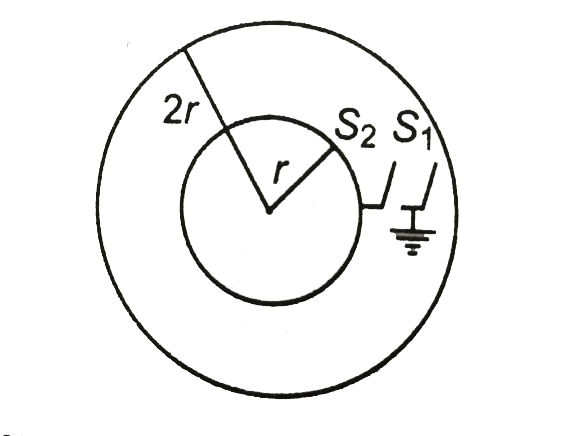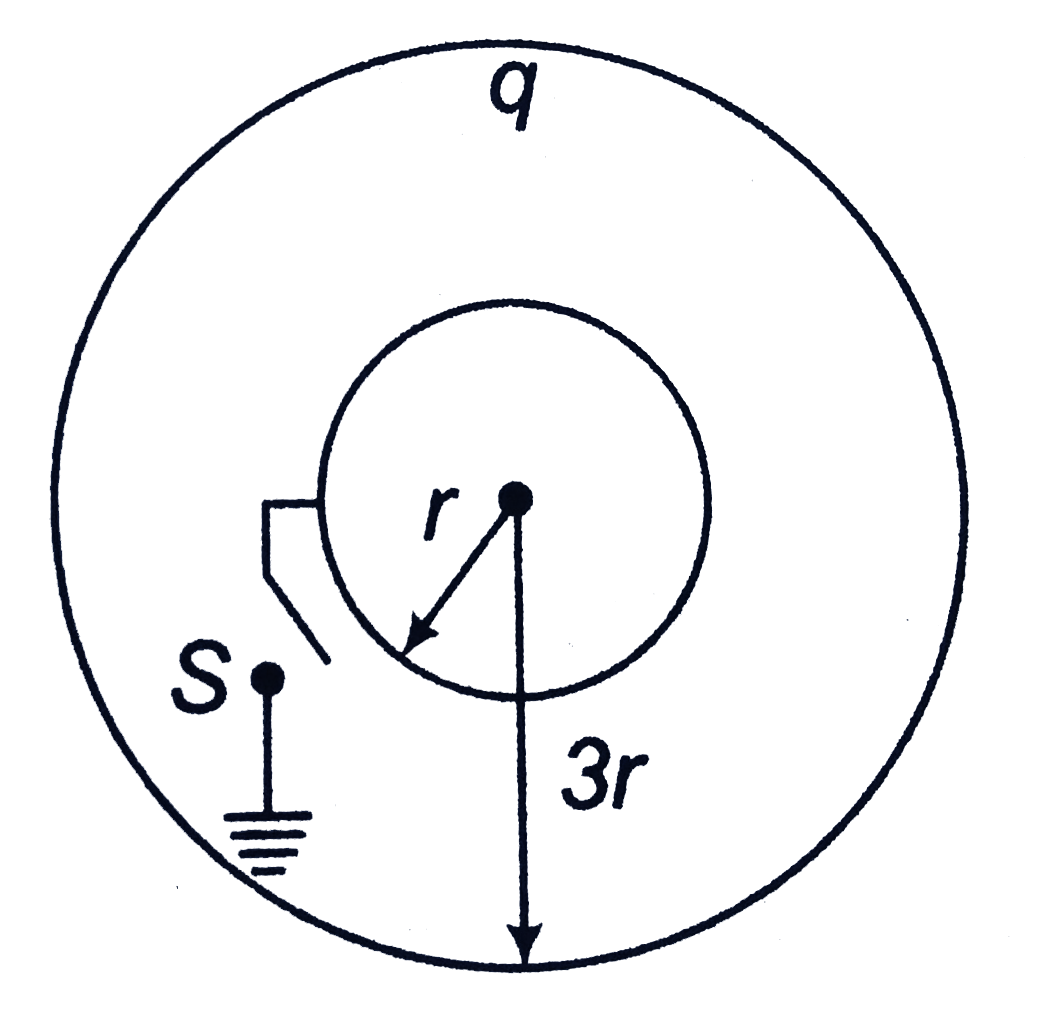There are two thin concentric conducting shells of radii a and b(a<b) . Equal charges Q given to each shell. Find the charge distribution on the inner and outer shell.
The charge distribution is as shown. For inner shells, there is no charge on inner surface because the charge enclosed by the Gaussian surface 1 must be zero.

The charge on inner surface of outer shall must be −Q because charge enclosed by Gaussian surface 2 must be zero.
As total charge of outer shell is Q, therefore a charge +2Q appears on the outer surface.
Topper's Solved these Questions
- ELECTROSTATIC POTENTIAL AND CAPACITANCE Book:AAKASH INSTITUTEChapter:ELECTROSTATIC POTENTIAL AND CAPACITANCE Exercise:TRY YOURSELF
Explore 110 Videos
- ELECTROSTATIC POTENTIAL AND CAPACITANCE Book:AAKASH INSTITUTEChapter:ELECTROSTATIC POTENTIAL AND CAPACITANCE Exercise:ASSIGNMENT (SECTION-A) Objective Type Questions (Only one answer)
Explore 47 Videos
- ELECTROMAGNETIC WAVESBook:AAKASH INSTITUTEChapter:ELECTROMAGNETIC WAVESExercise:ASSIGNMENT SECTION - D Assertion-Reason Type Questions
Explore 25 Videos
- GRAVITATION Book:AAKASH INSTITUTEChapter:GRAVITATION Exercise:ASSIGNMENT SECTION - D (ASSERTION-REASON TYPE QUESTIONS)
Explore 16 Videos
Similar Questions
There are three concentric shells or radii a,b and c(a<b<c) . Equal charges Q each are given to innermost and outermost shell . The middle shell is grounded. Determine the charge appearing on each surface of middle shell.
Strategy : When a conductor is grounded (i.e., connected to earth ) its potential becomes zero due to flow of charge either from shell or from ground.
View SolutionA point charge +q is placed at the centre of a conducting spherical shell of inner radius a and outer radius b. Find the charge appearing on the inner and outer surface of the shell.
View Solution
Knowledge Check
There are two concentric hollow conducting spherical shells of radii r and R(R>r). The charge on the outer shell is Q. What charge should be given to the inner shell, so that the potential at a point P , at a distance 2R from the common centre is zero ?
A−QrRB−QRrC−2QRrD−Q)Two concentric conducting spherical shells of radii a1anda2(a2>a1) are charged to potentials ϕ1 and ϕ2, respectively. Find the charge on the inner shell.
Aq1=4πε0(ϕ1−ϕ2a2−a1)a1a2Bq1=4πε0(ϕ1+ϕ2a2+a1)a1a2Cq1=πε0(ϕ1−ϕ2a2+a1)a1a2Dq1=2πε0(ϕ1+ϕ2a2−a1)a1a2In an arrangement of two concentric conducting shells, with centre at origin and radii a and b (a<b), charges Q1 and Q2 are given to inner and outer shell, then the potential V at a distance r from the origin is (r<a)
AV=kQ1a+kQ2bBV=kQ1r+kQ2aCV=kQ1a+kQ2rDV=k(Q1+Q2)r
There are two concentric conducting spherical shells of radius rA and rB respectively (rB=2rA). If the inner shell is given a charge Q and outer shell is given a charge 2Q, then the potential difference between the surfaces of the shells will be K=14πε0
View SolutionConsider two concentric spherical metal shells of radii r1 and r2(r2>r1). Find the charge on the inner shell and charge distribution.
View SolutionIn an arrangement of two concentric conducting shells, with centre at origin and radii a and b (a<b), charges Q1 and Q2 are given to inner and outer shell, then the potential V at a distance r from the origin is (r<a)
View SolutionThere are two concentric spherical shell of radii r and 2r. Initially, a charge Q is given to the inner shell and both the switches are open.

If switch S1 is closed and then opened, charge on the outer shell will be
View SolutionFigure shows two conducting thin concentric shells of radi r and 3r. The outer shell carries a charge q. Inner shell in neutral. Find the charge that wilL flow from inner shell to earth the switch S is closed.

View Solution

